Order of the British Empire
| Most Excellent Order of the British Empire | |
|---|---|
 | |
| Grand Cross' star of the Order of the British Empire | |
| Awarded by Sovereign of the United Kingdom | |
| Type | Order of Chivalry |
| Motto | For God and the Empire |
| Eligibility | British nationals or anyone who makes an impact for the UK |
| Awarded for | A national order of chivalry |
| Status | Currently constituted |
| Sovereign | Queen Elizabeth II |
| Grand Master | Prince Philip, Duke of Edinburgh |
| Principal Commander | Sovereign |
| Grades (w/ post-nominals) | Knight/Dame Grand Cross (GBE) Knight/Dame Commander (KBE/DBE) Commander (CBE) Officer (OBE) Member (MBE) |
| Established | 1917 |
| Precedence | |
| Next (higher) | Royal Victorian Order |
| Next (lower) | Varies, depending on rank |
| Military ribbon | |
| Civil ribbon | |
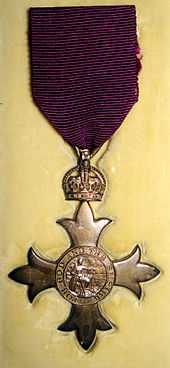
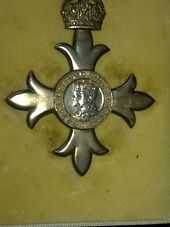
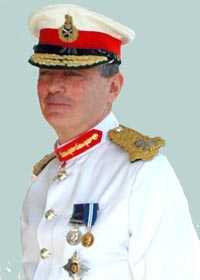
The Most Excellent Order of the British Empire is an order of chivalry established on 4 June 1917 by King George V.[1][2] The Order is composed of five classes in civil and military divisions. In descending order of seniority, these are:
- Knight Grand Cross or Dame Grand Cross of the Most Excellent Order of the British Empire (GBE)[lower-alpha 2]
- Knight Commander or Dame Commander of the Most Excellent Order of the British Empire (KBE or DBE)
- Commander of the Most Excellent Order of the British Empire (CBE)
- Officer of the Most Excellent Order of the British Empire (OBE)
- Member of the Most Excellent Order of the British Empire (MBE)
Only the highest two ranks automatically entitle its recipient to become a knight or dame, an honour allowing (but not prescribing) the postulant to use the title "Sir" (male) or "Dame" (female) before his or her first name (though men can be knighted separately from this and other Orders of Chivalry). Honorary knighthoods, given to individuals who are not nationals of a realm where Queen Elizabeth II is Head of State, permit use of the honour as a post-nominal but not as a title before their name. Awards in the Order of the British Empire were discontinued in those Commonwealth realms that established national systems of honours and awards such as the Order of Canada, the Order of Australia and the New Zealand Order of Merit. Foreign recipients are classified as honorary members of the Order they receive, and do not contribute to the numbers restricted to that Order as full members do.
There is also a related British Empire Medal, whose recipients are not members of the Order, but who are nonetheless affiliated with the Order. The British Empire Medal had not been used in the United Kingdom or its dependencies since 1993, but was revived in 2012 with 293 BEMs awarded for the Queen's Diamond Jubilee. In addition, BEM is used by the Cook Islands and by some other Commonwealth nations.
The Order's motto is For God and the Empire. It is the most junior of the British orders of chivalry, and the largest, with over 100,000 living members worldwide.[2]
History
King George V founded the order to fill gaps in the British honours system:
- the Most Honourable Order of the Bath honoured only senior military officers and civil servants;
- the Most Distinguished Order of St Michael and St George honoured diplomats and colonial officials;
- the Most Exalted Order of the Star of India and the Most Eminent Order of the Indian Empire honoured British and native officials in India; and
- the Royal Victorian Order honoured those who had personally served the Royal Family.
In particular, King George V wished to honour the many thousands of people who had served in numerous non-combatant capacities during the First World War. Originally, the Order included only one division; however, in 1918, soon after its foundation, it was formally divided into Military and Civil Divisions.[3]
Several previous foreign statesmen and diplomats who have performed service for, or on behalf of, the United Kingdom have been given the designations of Knight Commander or Knight Grand Cross of the Order. However, since membership requires swearing allegiance to a foreign Head of State (currently Queen Elizabeth II), these titles are officially considered "honorary", and the person is not entitled to be referred to as Sir or Dame. Occasionally the media incorrectly refer to foreign recipients with the prefix title, an example being Bob Geldof KBE, a citizen of the Republic of Ireland.
Composition
The British monarch is Sovereign of the Order, and appoints all other members of the Order (by convention, on the advice of the Government). The next most senior member is the Grand Master, of which there have been three: Prince Edward, the Prince of Wales (1917–1936); Queen Mary (1936–1953); and the current Grand Master, the Duke of Edinburgh (since 1953).
The Order is limited to 300 Knights and Dames Grand Cross, 845 Knights and Dames Commander, and 8,960 Commanders. There are no limits applied to the total number of members of the fourth and fifth classes, but no more than 858 Officers and 1,464 Members may be appointed per year. Appointments are made on the advice of the governments of the United Kingdom and some Commonwealth realms. By convention, female judges of the High Court of Justice are created Dames Commander after appointment, while male judges become Knights Bachelor.
Although the Order of the British Empire has by far the highest number of members of the British Orders of Chivalry, there are fewer appointments to knighthoods than in other orders. Most Knights Commander are honorary members or British citizens living abroad, with only a handful being residents of the United Kingdom.[citation needed] The grade of Dame Commander, on the other hand, is the most common grade of dame in the British honours system, and is awarded in circumstances in which men would be created Knights Bachelor.
Most members are citizens of the United Kingdom or the limited number of Commonwealth realms without their own national system of honours and awards. Citizens of other countries, however, may be admitted as "honorary members". They do not count towards the aforementioned numerical limits, and are not formally addressed as "Sir" or "Dame". They may be made full members if they subsequently become citizens of Commonwealth realms. See List of honorary British Knights.
At the foundation of the Order, the "Medal of the Order of the British Empire" was instituted. In 1922, it was renamed the "British Empire Medal". Recipients, who are not members of the Order itself, are grouped into the Civil and Military Divisions. Only junior government and military officials are awarded the medal; senior officials are directly appointed to the Order of the British Empire. The United Kingdom's Government ceased recommending the awarding of the medal in 1992, although some Commonwealth realms continued the practice, but resumed in June 2012 with awards to 293 people.[4]
The Order has six officials: the Prelate; the Dean; the Secretary; the Registrar; the King of Arms; and the Usher. The Bishop of London, a senior bishop in the Church of England, serves as the Order's Prelate. The Dean of St Paul's is ex officio the Dean of the Order. The Order's King of Arms is not a member of the College of Arms, as are many other heraldic officers. The Usher of the Order is known as the Gentleman Usher of the Purple Rod; he does not – unlike his Order of the Garter equivalent, the Gentleman Usher of the Black Rod – perform any duties related to the House of Lords.
From time to time, individuals are appointed to a higher grade within the Order, thereby ceasing usage of the junior post-nominal letters.
Gallantry
From 1940 the Sovereign could appoint a person as a Commander, Officer or Member of the Order of the British Empire for gallantry, for acts of bravery (not in the face of the enemy) which ranked below the level required for the George Medal, with the grade being determined by the same criteria as usual and not by the level of gallantry (and with more junior people instead receiving the British Empire Medal). Oddly, this meant that it was awarded for lesser acts of gallantry than the George Medal, but, as an Order, was worn before it and listed before it in post-nominal initials. From 14 January 1958, these awards were designated the Order of the British Empire for Gallantry.[5] Any individual made a member of the Order for gallantry could wear an emblem of two crossed silver oak leaves on the same riband, ribbon or bow as the badge. It could not be awarded posthumously and was effectively replaced in 1974 with the Queen's Gallantry Medal. If recipients of the Order of the British Empire for Gallantry received promotion within the Order, whether for gallantry or otherwise, they continued to wear also the insignia of the lower grade with the oak leaves.[6] However, they only used the post-nominal letters of the higher grade.
Vestments and accoutrements

Members of the Order wear elaborate costumes on important occasions (such as quadrennial services and coronations), which vary by rank (the designs underwent major changes in 1937):
- The mantle, worn by only Knights and Dames Grand Cross, was originally made of yellow satin lined with blue silk, but is now made of purple satin lined with pearl-grey silk. On the left side is a representation of the star (see below).
- The collar, also worn by only Knights and Dames Grand Cross, is made of gold. It consists of six medallions depicting the Royal Arms, alternating with six medallions depicting the Royal and Imperial Cypher of George V ("GRI", which stands for "Georgius Rex Imperator"). The medallions are linked with gold cables depicting lions and crowns.
On certain "collar days" designated by the Sovereign, members attending formal events may wear the Order's collar over their military uniform, formal day dress, or evening wear. When collars are worn (either on collar days or on formal occasions such as coronations), the badge is suspended from the collar. Collars are returned upon the death of their owners, but other insignia may be retained.
At less important occasions, simpler insignia are used:
- The star is an eight-pointed silver star used by only Knights and Dames Grand Cross and Knights and Dames Commander. It is worn pinned to the left breast. Varying in size depending on class, it bears a crimson ring with the motto of the Order inscribed. Within the ring, a figure of Britannia was originally shown. Since 1937, however, the effigies of George V and Mary of Teck have been shown instead.
- The badge is the only insignia used by all members of the Order. Until 1937, it was suspended on a purple ribbon, with a red central stripe for the military division; since then, the ribbon has been rose-pink with pearl-grey edges, with the addition of a pearl-grey central stripe for the military division. Knights and Dames Grand Cross wear it on a riband or sash, passing from the right shoulder to the left hip. Knights Commander and male Commanders wear the badge from a ribbon around the neck; male Officers and Members wear the badge from a ribbon on the left chest; all females other than Dames Grand Cross wear it from a bow on the left shoulder. The badge is in the form of a cross patonce (having the arms growing broader and floriated toward the end), the obverse of which bears the same field as the star (that is, either Britannia or George V and Queen Mary); the reverse bears George V's Royal and Imperial Cypher. Both are within a ring bearing the motto of the Order. The size of the badges varies according to rank: the higher classes have slightly larger badges. The badges of Knights and Dames Grand Cross, Knights and Dames Commander and Commanders are enamelled with pale blue crosses and crimson rings; those of Officers are plain gold; those of Members are plain silver.
- The British Empire Medal is made of silver. On the obverse is an image of Britannia surrounded by the motto, with the words "For Meritorious Service" at the bottom; on the reverse is George V's Imperial and Royal Cypher, with the words "Instituted by King George V" at the bottom. The name of the recipient is engraved on the rim. This medal is nicknamed "the Gong", and comes in both a full-sized and miniature versions – the latter for formal white-tie and informal black-tie occasions.
- A lapel pin for everyday wear was first announced at the end of December 2006, and is available to recipients of all levels of the Order, as well as to holders of the British Empire Medal. The pin design is not unique to any level. The pin features the badge of the Order, enclosed in a circle of ribbon of its colours of pink and grey. Lapel pins must be purchased separately by a member of the Order at the fixed price of £19.50.[7] The creation of such a pin was recommended in Sir Hayden Phillips' review of the honours system in 2004.[8]
-

Member (MBE) badge with civil ribbon, obverse and reverse
-

Full MBE medal with civil ribbon and the case in which it was presented.
-

Neck badge as worn by Commanders (CBE), Knight Commanders (KBE) and Dame Commanders (DBE) with military ribbon
-

A Knight/Dame Grand Cross' (GBE) mantle
-
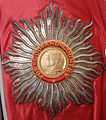
Close up of the star on a Knight/Dame Grand Cross' mantle
-

Star and neck badge of a Knight Commander (KBE), civil division
| Order of the British Empire ribbon bars | ||
|---|---|---|
| Civil | Military | |
| 1917–1935 | |
|
| Since 1936 | |
|
Chapel
The chapel of the order is in the far eastern end of the crypt of St Paul's Cathedral, but it holds its great services upstairs in the main body of the Cathedral. (The Cathedral also serves as the home of the chapel of The Most Distinguished Order of St Michael and St George.) Religious services for the whole Order are held every four years; new Knights and Dames Grand Cross are installed at these services. The chapel was dedicated in 1960.
Precedence and privileges
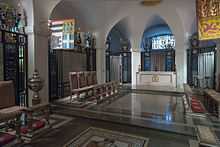
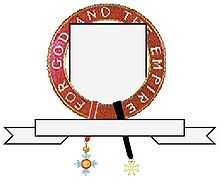
Members of all classes of the Order are assigned positions in the order of precedence. Wives of male members of all classes also feature on the order of precedence, as do sons, daughters and daughters-in-law of Knights Grand Cross and Knights Commander; relatives of Ladies of the Order, however, are not assigned any special precedence. As a general rule, individuals can derive precedence from their fathers or husbands, but not from their mothers or wives (see order of precedence in England and Wales for the exact positions).
Knights Grand Cross and Knights Commander prefix Sir, and Dames Grand Cross and Dames Commander prefix Dame, to their forenames.[lower-alpha 3] Wives of Knights may prefix Lady to their surnames, but no equivalent privilege exists for husbands of Dames. Such forms are not used by peers and princes, except when the names of the former are written out in their fullest forms. Male clergy of the Church of England or the Church of Scotland do not use the title Sir as they do not receive the accolade (i.e., they are not dubbed "knight" with a sword), although they do append the post-nominal letters.
Knights and Dames Grand Cross use the post-nominal, GBE; Knights Commander, KBE; Dames Commander, DBE; Commanders, CBE; Officers, OBE; and Members, MBE. The post-nominal for the British Empire Medal is BEM.
Knights and Dames Grand Cross and Knights and Dames Commander who are not citizens of Commonwealth realms can be awarded honorary titles, but do not receive the accolade and are not entitled to the prefix Sir or Dame, but may still use the post-nominal abbreviations. For example, American Bill Gates was made a Knight Commander, but is not entitled Sir Bill or Sir Bill Gates, although he may use the title Bill Gates, KBE. Bob Geldof, KBE received a knighthood in 1986 and although he is often referred to as Sir Bob, he is not a citizen of a Commonwealth realm and he is not entitled to use the prefix Sir. If recipients later become citizens of Commonwealth realms, then they are usually made substantive members of the Order, and are entitled to begin using the Sir prefix. For example, Irish broadcaster Terry Wogan was appointed an honorary KBE in 2005. He subsequently took dual British and Irish nationality, was made a substantive member, and is now entitled to use the name, Sir Terry Wogan.[9]
Knights and Dames Grand Cross are also entitled to be granted heraldic supporters. They may, furthermore, encircle their arms with a depiction of the circlet (a circle bearing the motto) and the collar; the former is shown either outside or on top of the latter. Knights and Dames Commander and Commanders may display the circlet, but not the collar, surrounding their arms. The badge is depicted suspended from the collar or circlet.
Current Knights and Dames Grand Cross
- Sovereign: Queen Elizabeth II
- Grand Master: Prince Philip, Duke of Edinburgh
- King of Arms: Admiral Sir Peter Abbott, GBE KCB
Knights and Dames Grand Cross
| Name | Post-nominals | Year appointed |
|---|---|---|
| | KG KT OM ONZ GBE AC QSO GCL CC CMM PC ADC(P) | 1953 |
| | GBE KCB DFC* | 1978 |
| | GBE QC | 1978 |
| | GBE KCB MC | 1985 |
| | GBE KCB MC* DL | 1985 |
| | GBE QPM | 1987 |
| | GBE | 1989 |
| | GBE PC QC | 1989 |
| | GBE KCB DFC | 1989 |
| | GBE KCB | 1989 |
| | GBE KCB DSO | 1990 |
| | GBE KCB DSO | 1990 |
| | GBE | 1990 |
| | GCB GBE | 1991 |
| | GBE | 1991 |
| | GBE | 1991 |
| | GBE | 1992 |
| | GBE KCB | 1992 |
| | GBE KCB | 1994 |
| | GBE CB AFC | 1998 |
| | OM GBE | 1998 |
| | GBE KCB | 1999 |
| | GBE | 1999 |
| | GBE | 2000 |
| | GBE KCB | 2002 |
| | GBE | 2002 |
| | GBE QPM | 2002 |
| | GBE | 2004 |
| | GBE PC | 2005 |
| | GBE | 2007 |
| | GBE KCB ADC Gen | 2011 |
| | GBE | 2011 |
| | GBE | 2011 |
| | GBE DL | 2011 |
| | GBE | 2012 |
| | GBE PC | 2012 |
| | GBE DL | 2013 |
| | GBE | 2013 |
Honorary
| Name | Post-Nominal | Country | Year appointed |
| | GBE | United States | 1999 |
Criticism
The order has attracted some criticism for its connection with the idea of the British Empire.[10] Benjamin Zephaniah, a British Jamaican poet, publicly rejected an OBE in 2003 because, he asserted, it reminded him of "thousands of years of brutality". He also said that "It reminds me of how my foremothers were raped and my forefathers brutalised."[11]
In 2004, a House of Commons Select Committee recommended changing the name of the award to the Order of British Excellence and changing the rank of Commander to Companion, as the former was said to have a "militaristic ring".[10][12]
A notable person to decline the offer of membership was the author C. S. Lewis (1898–1963), who had been named on the last list of honours by George VI in December 1951 but declined so as to avoid association with any political issues.[13][14]
The members of The Beatles were made MBEs in 1965. John Lennon justified the comparative merits of his investiture by comparing military membership in the order: "Lots of people who complained about us receiving the MBE [status] received theirs for heroism in the war – for killing people… We received ours for entertaining other people. I'd say we deserve ours more." Lennon returned his MBE insignia on 25 November 1969 as part of his ongoing peace protests.[15] Other criticism centres on the claim that many recipients of the Order are being rewarded with honours for simply doing their jobs, they claim that the civil service and judiciary receive far more orders and honours than leaders of other professions.[10]
Chin Peng, long-time leader of the Malayan Communist Party, was appointed an OBE for his share in fighting against the Japanese during World War II, in close cooperation with the British commando Force 136. It was withdrawn by the British government (and became undesirable for Chin Peng himself) when the Communist leader headed his party's guerrilla insurgency against the British in the Malayan Emergency.[16]
See also
| Wikimedia Commons has media related to Order of the British Empire. |
- British honours system
- Knight Bachelor
- List of Dames Commander of the Order of the British Empire
- List of Dames Grand Cross of the Order of the British Empire
- List of honorary British Knights
- List of Knights Grand Cross of the Order of the British Empire
- United Kingdom order of precedence
Footnotes
- Notes
- ↑ In the image provided, the recipient has also been received into the Venerable Order of Saint John, and so that badge is shown also, on the black ribbon to the right.
- ↑ It is incorrect to omit "of the Most Excellent Order" and other important words not implied by the initials. The British Empire no longer exists as a formal entity, but the Order of the British Empire continues.
- ↑ Never surnames – thus Sir Antony Sher may be shortened to Sir Antony, but not to Sir Sher
- References
- ↑ The London Gazette: (Supplement) no. 30250. pp. 7791–7999. 1917-08-24. Retrieved 2010-06-13.Original Order of the British Empire Statutes dated 24 Aug 1917
- ↑ 2.0 2.1 The Monarchy Today > Queen and public > Honours > Order of the British Empire royal.gov.uk: The Official Website of the British Monarchy, Accessed 24 August 2009
- ↑ The London Gazette: no. 31084. p. 15135. 27 December 1918.
- ↑ "Birthday Honours: 'Working class' British Empire Medal revived". BBC News. Retrieved 20 June 2012.
- ↑ The London Gazette: (Supplement) no. 41285. p. 365. 14 January 1958.
- ↑ The London Gazette: (Supplement) no. 56878. p. 3353. 17 March 2003.
- ↑ Emblems for honours at the Government website, 27 May 2012
- ↑ Reform of the Honours system, Cabinet Office, February 2005, PDF, 648 kb download
- ↑ Radio's Wogan becomes Sir Terry. BBC News, 6 December 2005, Retrieved 7 February 2009
- ↑ 10.0 10.1 10.2 A Reformed Honours system, Select Committee on Public Administration, 7 July 2004, Retrieved 13 May 2012
- ↑ Mills, Merope (2003-11-27). "Rasta poet publicly rejects his OBE". The Guardian, 27 November 2003. Retrieved on 2007-02-28 from http://www.guardian.co.uk/uk_news/story/0,3604,1094118,00.html.
- ↑ "Honours system outdated, say MPs", BBC News, 13 July 2004, Retrieved 28 February 2007
- ↑ "Chronology of the Life of C.S. Lewis".
- ↑ C.S., Lewis (1994). W. H. Lewis, Walter Hooper, ed. Letters of C.S. Lewis. New York: Mariner Books. p. 528. ISBN 0-15-650871-0.
- ↑ Brian Roylance; George Harrison, John Lennon, Paul McCartney, Ringo Starr (2000). The Beatles Anthology. Chronicle Books. p. 183. ISBN 0-8118-2684-8.
- ↑ Dead or Alive,(subscription required) TIME Magazine, May 12, 1952
External links
- Honours, Decorations & Awards UK Government
- The London Gazette lists recipients of honours
- Cambridge University Heraldic and Genealogical Society, (2002), "The Most Excellent Order of the British Empire"
- Galloway, Peter (1996). The Order of the British Empire. Central Chancery of the Orders of Knighthood. ISBN 0-907605-65-6.
- "Knighthood and Chivalry" (1911). Encyclopædia Britannica, 11th ed. London: Cambridge University Press
- Velde, F. R. (2003). "Order of Precedence in England and Wales
- The Chapel of the Most Excellent Order of the British Empire by Frederic Hood, with a foreword by Prince Philip
- Search recommendations for the Order of the British Empire on The UK National Archives' website
- The Chapel of the Most Excellent Order of the British Empire – OBE Chapel Exterior detail
| ||||||||||||||
|